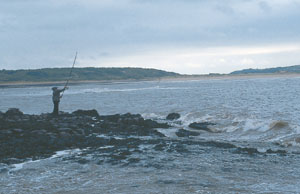 |
The bay at
Newton is an all-year-round venue providing bass, smoothhounds, flatties, small-eyed and thornback rays, mullet and garfish. In autumn the occasional double-figure bass make an appearance together with big conger eels. In early winter the venue is noted for its catches of codling and whiting, but dogfish can be a nuisance! Double-figure cod are sometimes taken in winter, especially after dark. Care should be taken as the flooding tide can come in behind you, cutting you off from your retreat. When the water clears after long calm spells, plugging or spinning can be a successful method.
The Point
This rough, rocky area juts out into the strong currents of the
Only fish it over the slack-water period with mackerel head and guts for big eels or bass in the summer. Big cod are possible to squid and lug cocktails on Pennell rigs in the winter months. This mark offers difficult fishing but it could be worthwhile putting in the effort.
The Sewer Pipe
Inside the point buried in the sand is an old pipe no longer in use. This is one of the best marks for autumn codling. Fish either side of the pipe onto rough ground two hours back and two hours up. It’s a good spot for smoothhounds to crabs on balmy summer evenings. Long casts will reach small-eyed or thornback rays to fish, squid or crab baits. Bass move through on the flooding tide and are often close in around the gullies. The top baits here for the bass are crabs.
The Inner Point
This rocky point separates the inner bay from the main outer channel. It’s best to check out the bottom at low water to note the reefs, which appear at average casting distance. These reefs hide the food the fish need, which is why this mark often produces the goods.
Careful casting could produce a mixed bag of fish including eels, dogfish, smoothhounds, pouting, rockling and in really hot summers there is a good chance of a rare triggerfish. Fish two hours before low and two hours up.
The Middle Sands
Further inside the bay there are sandy patches and more mixed ground. Flatties, including the occasional small plaice, follow the tide in here. Care should be taken as the water can come in behind you. Ragworm on a flowing trace is a good bet for the flatties. It is best fished around the middle tide. As the tide rises, mullet often roam in the weed beds among the rocks. Groundbaiting with mashed bread and using small harbour rag under a float can prove successful. There’s always a chance of a school bass or two here as well.
The Boulders
Towards the top end of the tide, on the eastern side of the bay, the ground becomes much rougher. On the middle and west side there is a good stretch of clean ground, which allows boats to access the main beach area. In the height of summer on calm days, speedboats and water skis can be a nuisance. Fishing the point made of stones and boulders on the western side enables you to fish onto reasonably clean ground and intercept fish as they travel into the beach area. Pouting, whiting and codling feature in early winter; school bass, rockling, eels and flatties in summer.
The Main Beach
This is a beautiful sandy beach but it is well populated in summer with boats and swimmers. It’s best fished over high water on medium-range springs, especially the first couple of hours of the ebb. Fishing after dark produces better results. Summer evenings give the chance of a ray or smoothhound to long casts. Bass prefer a good surf. In winter, after dark, good-sized cod are sometimes taken, together with good bags of whiting. Fishing close to the rocks often produces the better catches. Flatties prefer the sandier areas near freshwater streams.
Tackle Shops
Porthcawl Angling Centre, 10 Dock Street, Porthcawl. Tel: 01656 772404
Ewenny Angling Supplies, 11b Ewenny Road, Bridgend. Tel: 01656 662691
TSF Top Tip 1
Carry a selection of plugs and spinners with you at all times. You never know when the bass will show up.
TSF Top Tip 2
If you fancy a crack at the mullet, try groundbaiting with bread and fish bread flake or harbour rag under a float.





